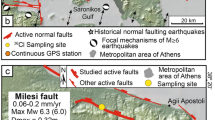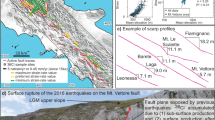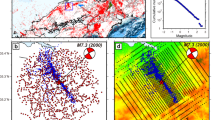Abstract
The time-varying deformation field within a fault zone, particularly at depths where earthquakes occur, is important for understanding fault behaviour and its relation to earthquake occurrence1,2,3. But detection of this temporal variation has been extremely difficult, although laboratory studies have long suggested that certain structural changes, such as the properties of crustal fractures, should be seismically detectable4. Here we present evidence that such structural changes are indeed observable. In particular, we find a systematic temporal variation in the seismograms of repeat microearthquakes that occurred on the Parkfield segment of the San Andreas fault over the decade 1987–97. Our analysis reveals a change of the order of 10 m in the location of scatterers which plausibly lie within the fault zone at a depth of ∼3 km. The motion of the scatterers is coincident, in space and time, with the onset of a well documented aseismic transient (deformation event). We speculate that this structural change is the result of a stress-induced redistribution of fluids in fluid-filled fractures caused by the transient event.
This is a preview of subscription content, access via your institution
Access options
Subscribe to this journal
Receive 51 print issues and online access
$199.00 per year
only $3.90 per issue
Buy this article
- Purchase on Springer Link
- Instant access to full article PDF
Prices may be subject to local taxes which are calculated during checkout





Similar content being viewed by others
References
Stein, R. S. The role of stress transfer in earthquake occurrence. Nature 402, 605–609 (1999)
Freed, A. M. & Lin, J. Delayed triggering of the 1999 Hector Mine earthquake by viscoelastic stress transfer. Nature 411, 180–183 (2001)
Bowman, D. D., Ouillon, G., Sammis, C. G., Sornette, A. & Sornette, D. An observational test of the critical earthquake concept. J. Geophys. Res. 103, 24359–24372 (1998)
Nur, A. Effects of stress on velocity anisotropy in rocks with cracks. J. Geophys. Res. 76, 2022–2034 (1971)
Bakun, W. H. & Lindh, A. G. The Parkfield, California, earthquake prediction experiment. Science 229, 619–624 (1985)
Gwyther, R. L., Gladwin, M. T., Mee, M. & Hart, R. H. G. Anomalous shear strain at Parkfield during 1993-94. Geophys. Res. Lett. 23, 2425–2428 (1996)
Langbein, J., Gwyther, R. L., Hart, R. H. G. & Gladwin, M. T. Slip-rate increase at Parkfield in 1993 detected by high-precision EDM and borehole tensor strainmeters. Geophys. Res. Lett. 26, 2529–2532 (1999)
Gao, S. S., Silver, P. G. & Linde, A. T. Analysis of deformation data at Parkfield, California: Detection of a long-term strain transient. J. Geophys. Res. 105, 2955–2968 (2000)
Nadeau, R. M. & McEvilly, T. V. Fault slip rates at depth from recurrence intervals of repeating microearthquakes. Science 285, 718–721 (1999)
Nadeau, R. M., Antolik, M., Johnson, P. A., Foxall, W. & McEvilly, T. V. Seismological studies at Parkfield III: Microearthquake clusters in the study of fault-zone dynamics. Bull. Seismol. Soc. Am. 84, 247–263 (1994)
Waldhauser, F. & Ellsworth, W. L. A double-difference earthquake location algorithm: method and application to the northern Hayward fault. Bull. Seismol. Soc. Am. 90, 1353–1368 (2000)
Dodge, D. A. & Beroza, G. C. Source array analysis of coda waves near the 1989 Loma Prieta, California, mainshock: Implications for the mechanism of coseismic velocity changes. J. Geophys. Res. 102, 24437–24458 (1997)
Baisch, S. & Bokelmann, G. H. Seismic waveform attributes before and after the Loma Prieta earthquake: Scattering change near the earthquake and temporal recovery. J. Geophys. Res. 106, 16323–16337 (2001)
Aki, K. & Richards, P. G. Quantitative Seismology: Theory and Methods (Freeman, San Francisco, 1980)
Kanamori, H. & Anderson, D. L. Theoretical basis of some empirical relations in seismology. Bull. Seismol. Soc. Am. 65, 1073–1095 (1975)
Snieder, R., Gret, A., Douma, H. & Scales, J. Coda wave interferometry for estimating nonlinear behavior in seismic velocity. Science 295, 2253–2255 (2002)
Nadeau, R. M. & McEvilly, T. V. Seismological studies at Parkfield; V, Characteristic microearthquake sequences as fault-zone drilling targets. Bull. Seismol. Soc. Am. 87, 1463–1472 (1997)
Poupinet, G., Ratdomopurbo, A. & Coutant, O. On the use of earthquake multiplets to study fractures and the temporal evolution of an active volcano. Ann. Geofis. 39, 253–264 (1996)
Acknowledgements
We thank the people who are involved in the installation and maintenance of the High Resolution Seismic Network, and also thank M. Fehler, P. Malin, E. Roeloffs, C. Thurber and L. Wen for discussions, and A. Rubin and S. Roecker for reviews. This work was supported by the Carnegie Institution of Washington, Rice University, NASA and USGS. Partial processing of the data was done at the University of California's Berkeley Seismological Laboratory and at the Center for Computational Seismology (CCS) at the Lawrence Berkeley National Laboratory.
Author information
Authors and Affiliations
Corresponding author
Ethics declarations
Competing interests
The authors declare that they have no competing financial interests.
Rights and permissions
About this article
Cite this article
Niu, F., Silver, P., Nadeau, R. et al. Migration of seismic scatterers associated with the 1993 Parkfield aseismic transient event. Nature 426, 544–548 (2003). https://doi.org/10.1038/nature02151
Received:
Accepted:
Issue Date:
DOI: https://doi.org/10.1038/nature02151
This article is cited by
-
Catalog of small repeating earthquakes for the Japanese Islands
Earth, Planets and Space (2020)
-
Probing complex geophysical geometries with chattering dust
Nature Communications (2020)
-
Seismic velocity reduction and accelerated recovery due to earthquakes on the Longmenshan fault
Nature Geoscience (2019)
-
Semiannual velocity variations around the 2008 Mw 7.9 Wenchuan Earthquake fault zone revealed by ambient noise and ACROSS active source data
Earthquake Science (2014)
-
Large slip rate detected at the seismogenic zone of the 2008 MW7.9 Wenchuan earthquake
Earthquake Science (2011)
Comments
By submitting a comment you agree to abide by our Terms and Community Guidelines. If you find something abusive or that does not comply with our terms or guidelines please flag it as inappropriate.



